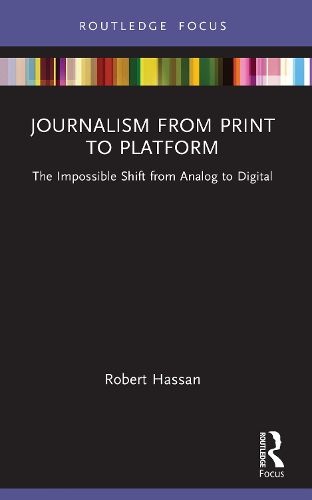Readings Newsletter
Become a Readings Member to make your shopping experience even easier.
Sign in or sign up for free!
You’re not far away from qualifying for FREE standard shipping within Australia
You’ve qualified for FREE standard shipping within Australia
The cart is loading…






Through a synthesis of philosophical anthropology and media theory, this book examines the human relationship with technology, progressing from analogue to digital, to give a new perspective on journalism in the digital age.
Journalism from Print to Platform takes a fresh look at the relationship between journalism as a craft shaped by its tools and considers anew the tools themselves. This book demonstrates that, with the emergence of digitality, what analogue print culture made possible and seemingly "natural" has now become unworkable. Digital logic constitutes a wholly different category of technology with a framework that makes fidelity in one-to-one exchange of analogue-to-digital in communication problematic. In short, the technology-based forms and practices that journalism developed as a fourth estate/public sphere enabler are, like us, irreducibly analog. Whilst we have mostly assumed that these would either adapt to or carry over with the shift to digitality, this book challenges that assumption and considers the important consequences of that realisation for the practice of journalism today.
This challenging study is an insightful resource for students and scholars in journalism, media and technology studies.
$9.00 standard shipping within Australia
FREE standard shipping within Australia for orders over $100.00
Express & International shipping calculated at checkout
Through a synthesis of philosophical anthropology and media theory, this book examines the human relationship with technology, progressing from analogue to digital, to give a new perspective on journalism in the digital age.
Journalism from Print to Platform takes a fresh look at the relationship between journalism as a craft shaped by its tools and considers anew the tools themselves. This book demonstrates that, with the emergence of digitality, what analogue print culture made possible and seemingly "natural" has now become unworkable. Digital logic constitutes a wholly different category of technology with a framework that makes fidelity in one-to-one exchange of analogue-to-digital in communication problematic. In short, the technology-based forms and practices that journalism developed as a fourth estate/public sphere enabler are, like us, irreducibly analog. Whilst we have mostly assumed that these would either adapt to or carry over with the shift to digitality, this book challenges that assumption and considers the important consequences of that realisation for the practice of journalism today.
This challenging study is an insightful resource for students and scholars in journalism, media and technology studies.